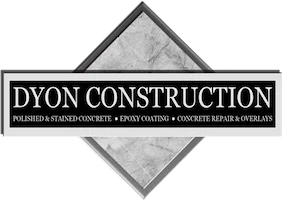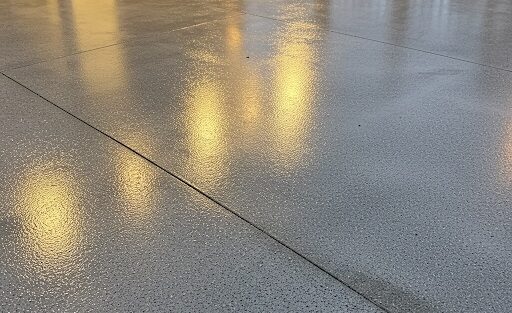Concrete surfaces are known for their strength and longevity, but even the most resilient slabs can become cracked, worn, or outdated over time. Instead of ripping out and replacing old concrete, a concrete overlay can provide a cost-effective and durable solution to restore, enhance, or transform floors, patios, and driveways.
But what exactly is a concrete overlay, and how does it work? In this guide, we’ll explore the different types of overlays, their benefits, and the best applications for each, helping you make an informed decision about revamping your concrete surfaces.
What Is a Concrete Overlay?
A concrete overlay is a thin layer of cement-based or polymer-modified material applied over an existing concrete surface to improve its appearance, fix minor damage, and enhance its durability. Overlays are available in a variety of textures, colors, and finishes, allowing for both decorative and functional applications.
Unlike pouring new concrete, overlays adhere to the existing surface, requiring minimal demolition and offering a quicker, more affordable alternative to replacement. Whether you need to level uneven floors, create a decorative stamped pattern, or protect high-traffic areas from wear and tear, concrete overlays provide versatile, long-lasting solutions.
Types of Concrete Overlays
There’s no one-size-fits-all when it comes to overlays. Each type serves a specific purpose, catering to different aesthetic preferences, durability requirements, and installation conditions. Below is a detailed comparison of the most popular options.
Overlay Type | Pros | Cons | Ideal For | Price Range (per sq. ft.) | Durability | Maintenance |
Thin Concrete Overlay | Smooth & even surface, works over existing concrete | Limited to minor surface damage | Indoor floors, patios, walkways | $3–$7 | 10–15 years | Low |
Stamped Concrete Overlay | Mimics brick, stone, wood, highly decorative | Requires professional installation | Patios, driveways, pool decks | $5–$12 | 15+ years | Medium |
Microtopping Overlay | Ultra-thin, modern seamless look | Less durable than thicker overlays | Interior floors, countertops | $3–$6 | 5–10 years | Low |
Self-Leveling Overlay | Levels uneven floors, high strength | More expensive than standard overlays | Warehouses, commercial spaces | $4–$9 | 10–20 years | Low |
Polymer-Modified Overlay | Strong adhesion, resistant to cracking | Requires proper surface preparation | Garage floors, industrial areas | $4–$10 | 15+ years | Low |
Benefits of Concrete Overlays
1. Cost-Effective Alternative to Replacement
Removing and replacing a concrete slab can be expensive and time-consuming. Concrete overlays offer a budget-friendly solution that rejuvenates existing surfaces without the need for demolition or new concrete pouring.
2. Customization & Decorative Appeal
With various textures, colors, and stamped designs, overlays can mimic high-end materials like stone, tile, and wood, offering a luxurious finish at a fraction of the cost.
3. Improved Durability & Longevity
Many overlays are formulated with high-strength materials, making them resistant to cracking, moisture, and UV damage. Properly sealed overlays can last 10–20+ years, even in harsh environments.
4. Versatile Indoor & Outdoor Applications
Whether you’re resurfacing a garage floor, warehouse, patio, or commercial space, there’s an overlay tailored for your specific needs. Some overlays enhance aesthetic appeal, while others provide industrial-grade toughness.
5. Low Maintenance
Unlike other flooring materials that require frequent upkeep, most overlays only need occasional cleaning and resealing to maintain their appearance and performance.
Best Applications for Concrete Overlays
1. Residential Floors
For homeowners looking for a sleek, durable flooring solution, concrete overlays are a great alternative to tile, wood, or carpet. They are especially popular in modern homes, where microtoppings and polished overlays create a seamless, contemporary look.
2. Driveways & Walkways
Driveways can take a beating from cars, weather exposure, and daily wear. Stamped concrete overlays provide an aesthetic and functional upgrade, offering the look of pavers, bricks, or stone with added strength.
3. Patios & Pool Decks
Outdoor surfaces like patios and pool decks benefit from decorative overlays that enhance slip resistance, UV protection, and weather resistance. Stamped concrete overlays can transform an old patio into a high-end outdoor oasis.
4. Commercial & Industrial Spaces
For warehouses, factories, and retail stores, self-leveling and polymer-modified overlays provide a flat, durable, and impact-resistant surface capable of withstanding heavy traffic and machinery.
5. Garage & Workshop Floors
Garage floors require durability and chemical resistance to withstand oil spills, tire marks, and heavy equipment. Polymer-modified overlays offer a high-performance surface that resists damage and is easy to clean.
Frequently Asked Questions
What is a concrete overlay?
A concrete overlay is a thin layer of cementitious material applied over existing concrete to restore, enhance, or protect the surface. It can be used for decorative, functional, and structural improvements.
What are the disadvantages of concrete overlays?
- Not a Fix for Structural Issues – Overlays are best for surface-level repairs and cannot fix major cracks or foundational problems.
- Surface Preparation is Crucial – Poor prep work can lead to peeling, bubbling, or adhesion failure.
- Requires Periodic Sealing – Some overlays need sealing every few years to maintain durability and appearance.
How long do concrete overlays last?
Depending on the type of overlay and level of maintenance, concrete overlays can last anywhere from 5 to 20+ years. Stamped and polymer-modified overlays tend to have the longest lifespans.
How much does a concrete overlay cost?
The cost of a concrete overlay depends on factors like material type, surface preparation, and design complexity. Prices typically range from $3 to $12 per square foot, with decorative and stamped overlays on the higher end.
How strong is a concrete overlay?
Concrete overlays are designed to withstand heavy foot traffic, vehicles, and extreme weather conditions. Polymer-modified and self-leveling overlays offer high compressive strength, making them ideal for commercial and industrial applications.
Concrete overlays are an innovative, budget-friendly, and long-lasting solution for revitalizing old, worn-out concrete surfaces. Whether you’re looking for a simple refresh, a decorative enhancement, or a heavy-duty flooring upgrade, overlays provide customization, durability, and aesthetic appeal at a fraction of the cost of new concrete.
From sleek interior floors to robust outdoor patios, overlays offer limitless design potential, transforming bland concrete into something truly spectacular. If your concrete is showing signs of wear but still structurally sound, a concrete overlay might be the perfect solution to extend its lifespan and elevate its appearance.

